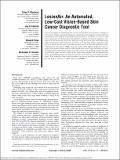LesionAir: An Automated, Low-Cost Vision-Based Skin Cancer Diagnostic Tool
Author(s)
Carlson, Jay D.; Perez, Edward; Wortman, Tyler D.; Slocum Jr., Alexander H
Downloadmed_012_02_021001.pdf (2.166Mb)
PUBLISHER_POLICY
Publisher Policy
Article is made available in accordance with the publisher's policy and may be subject to US copyright law. Please refer to the publisher's site for terms of use.
Terms of use
Metadata
Show full item recordAbstract
Current techniques for diagnosing skin cancer lack specificity and sensitivity, resulting in unnecessary biopsies and missed diagnoses. Automating tissue palpation and morphology quantification will result in a repeatable, objective process. LesionAir is a low-cost skin cancer diagnostic tool that measures the full-field compliance of tissue by applying a vacuum force and measuring the precise deflection using structured light three-dimensional (3D) reconstruction. The technology was tested in a benchtop setting on phantom skin and in a small clinical study. LesionAir has been shown to measure deflection with a 0.085mm root-mean-square (RMS) error and measured the stiffness of phantom tissue to within 20% of finite element analysis (FEA) predictions. After biopsy and analysis, a dermatopathologist confirmed the diagnosis of skin cancer in tissue that LesionAir identified as noticeably stiffer and the regions of this stiffer tissue aligned with the bounds of the lesion. A longitudinal, full-scale study is required to determine the clinical efficacy of the device. This technology shows initial promise as a low-cost tool that could rapidly identify and diagnose skin cancer.
Date issued
2018-03Department
Massachusetts Institute of Technology. Department of Mechanical EngineeringJournal
Journal of Medical Devices
Publisher
ASME International
Citation
Wortman, Tyler D., Jay D. Carlson, Edward Perez, and Alexander H. Slocum. “LesionAir: An Automated, Low-Cost Vision-Based Skin Cancer Diagnostic Tool.” Journal of Medical Devices 12, no. 2 (March 5, 2018): 021001. © 2018 by ASME
Version: Final published version
ISSN
1932-6181